Types of queen cells or how swarm queen cells differ from fistulous queen cells or quiet change
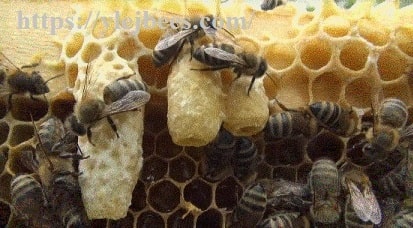 Photo of swarm queen cells in bees of the Far Eastern breed
Photo of swarm queen cells in bees of the Far Eastern breed
A beekeeper, while inspecting colonies, discovers different types of queen cells - swarm queen cells, fistulous queen cells, and quiet-shift queen cells. Each type of queen cell signals the beekeeper about certain processes that occur in the bee colony and require an individual approach to solving them. Therefore, the beekeeper should know what the queen cell looks like in bees, how swarm queen cells differ from fistulous queen cells, what a fistula queen cell looks like, how to choose the best fistula queen cell, in what cases what types of queen cells can be used and hundreds of other questions about queen cells and their use. After reading this article, you will learn which queen cell is better than a swarm or fistula queen cell, how to distinguish a fistulous queen cell from a swarm queen cell, how to choose a good fistula queen cell, why bees lay fistulous queen cells and much more. Read to the end - it will be interesting!
Content
- What is a queen cell?
- What does the queen cell look like?
- Types of queen cells in bees
- What are swarm queen bees?
- Where are the swarm queen cells located?
- Difference between fistula and swarm queen cells
- Which swarm queen cells are the best?
- Fistula queen cells in bees photo and description
- What are fistulous queen cells in bees?
- What is the difference between a fistulous queen cell and a swarm queen cell?
- On which larvae do bees lay fistulous queen cells?
- How many fistulous queen cells can there be in a hive?
- What to do if bees have laid fistulous queen cells?
- Which fistula queen cell is better to choose?
- Which queen cell is better to leave swarm or fistula?
- What are queen cells of quiet shift in bees?
- How many queen cells are there during a quiet queen change?
- How to determine the queen cell of a quiet shift
- How to distinguish a quiet-shift queen cell from a swarm queen cell
- How to distinguish a quiet shift queen cell from a fistulous queen cell
- Which queen cells are better - quiet shift, swarm, fistula?
What is a queen cell?
Before considering what types of queen cells exist and what are the differences between them, it is necessary to consider what a queen cell is.
What is a queen cell in simple words? The queen cell is a special type of cells in which bees breed queens.
The laying of queen cells occurs either in specially constructed bases of the queen cells - bowls, in the case of quiet shift queen cells or swarm queen cells, or the laying of queen cells occurs by rebuilding the working cell with the larva located in it, this happens in the case of fistulous queen cells.
How to breed wax moths in an apiary
Wax moth tincture for use in various diseases
How to prepare bee moth tincture
Bee moth contraindications for use
What does the queen cell look like?
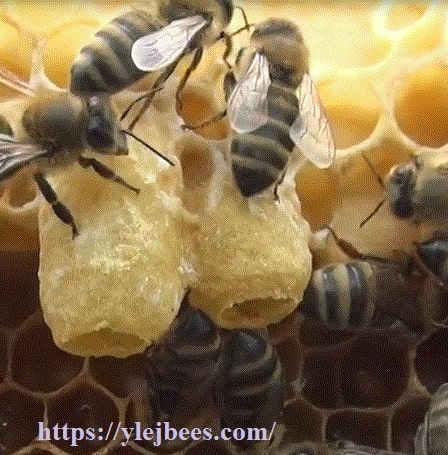 Photo of what a queen cell looks like on a bee frame
Photo of what a queen cell looks like on a bee frame
Let's look at what the queen cell looks like in bees. Queen cells in bees can be compared to acorns; they are very similar in shape. What does the queen cell look like in bees? At first, the bees have an open queen cell, in which they lay food for the queen, then the walls are lengthened as the larva grows and a sealed queen cell is obtained.
How long does it take for the uterus to emerge from the queen cell?
Who chews on queen cells and why?
Now you can consider what types of queen cells there are, how swarm queen cells differ from fistulous queen cells, and how to choose the best queen cell.
Types of queen cells in bees
Queen cells are an extremely valuable asset in an apiary. With the help of queen cells, a beekeeper can form layering, nucleuses, correct polypore colonies, help queenless colonies or replace the queen by substituting a queen cell into the family; with the help of queen cells, one can fight swarming and carry out other operations with bees.
First, let's look at what types of queen cells there are in bees - in nature, bees have three types of queen cells - swarm queen cells, fistulous queen cells, and quiet-shift queen cells. Each type of queen cell has its own characteristics and each type of queen cell is best used for a specific purpose.
What are swarm queen bees?
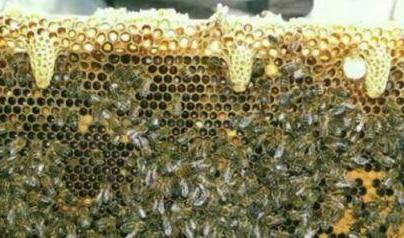 Photo of swarm queen cells in bees
Photo of swarm queen cells in bees
You can easily see what swarming queen cells look like in bees in the photo.
As you might guess, bees lay swarm queen cells during the period when they are preparing to swarm, most often this is May, June, and July. Bees lay swarm queen cells only in those families that have entered the swarm state; the number of swarm queen cells depends on the breed of bees and can range from several hundred swarm queen cells in Kuban broad-footed bees, to 10-50 swarm queen cells in Central Russian bees.
Where are the swarm queen cells located?
Where are swarm queen cells located in a bee nest? Most often, bees lay swarm queen cells around the perimeter of the comb; sometimes bees can have swarm queen cells in the center of the comb, but this is rare.
Difference between fistula and swarm queen cells
It must be said that fistulous swarming queen cells do not exist - either fistulous queen cells or swarming queen cells.
Fistula and swarm queen cells have a number of differences, but the most important difference is the quality of the queens. An important feature of swarm queen bees in chelas is that they first prepare bowls, and only then force the queen bee to lay an egg in it. As a result, from the very first hour, after the larva has hatched from the egg, it begins to be fed with specific food intended only for raising the queen bee, so from the swarm queen cells the bees get queens of very good quality. For this reason, beekeepers very often use swarm queen cells to form layering and cores. When making layering for swarm queen cells of bees, the best swarm queen cells are selected.
Which swarm queen cells are the best?
The best swarming queen cells can be recognized by the following characteristics:
- Swarm queen cells are located in the center of the comb; good queen cells are also obtained from swarm queen cells at the bottom of the comb. But you should not leave the swarm cells on the outermost frames near the covert; it is better to leave those located on the honeycombs inside the nest.
- Good swarm queen cells in bees must have the correct shape.
- The swarm queen cell should be positioned vertically.
- The optimal length of the swarm queen cell should be 20 - 25 mm; do not leave too small (in such queen cells the queen cells will be small) or abnormally large queen cells (as a rule, in such queen cells the larva has separated from the food and the bees involuntarily lengthen the queen cell).
Use of swarm queen cells in the apiary
Beekeepers often make layering to the swarm queen cell. Swarm queen cells for the formation of layering are used when they are mature - at the age of 14 days.
What to do if a family has established swarm queen cells?
Fistula queen cells in bees photo and description
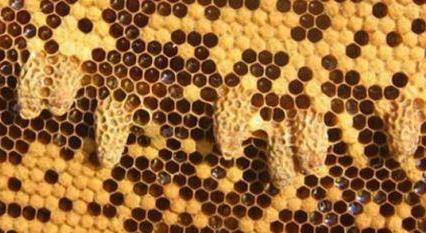
Photos of fistula queen cells
What are fistulous queen cells in bees?
First, let's define what a fistulous queen cell is in bees. Fistula queen cells in bees are queen cells that bees lay during the period when they suddenly lost their queen. What is a fistulous queen cell? In simple words, say, during an examination, she was crushed with a frame or shaken off into the grass, or for some other reason the queen disappeared and the bees laid the queen cell to hatch a new one.
Why do bees make fistulous queen cells? The answer is obvious, without a queen bee the family cannot exist and therefore they lay fistulous queen cells.
What does fistulous uterus mean in the family? This means that the queen bee has suddenly disappeared and the bees are raising a replacement for her. Fistula queen cells in a hive are not a rare occurrence; moreover, beekeepers often ensure that the bees lay fistula queen cells to hatch queens. It is also not difficult to create layering on a fistulous queen cell. It is important to create such conditions so that the bees lay high-quality fistulous queen cells. To do this, let’s look at how bees lay fistulous queen cells and how a beekeeper can choose a good fistulous queen cell.
What is the difference between a fistulous queen cell and a swarm queen cell?
What is the difference between a fistulous queen cell and a swarm queen cell, how to distinguish a fistulous queen cell from a swarm cell? As mentioned above, there are no fistulous swarming queen cells, compare photos of fistula and swarming queen cells.
- The most important thing is the nature of the queen cell - the instinct to reproduce or the need to urgently restore the viability of the family.
- The quality of queens can vary greatly if the beekeeper does not intervene.
- The location of fistulous and swarming queen cells on the honeycomb is different.
- Fistula and swarm queen cells have different “cells” - the laying of fistula queen cells is carried out by restructuring the working cell, and the laying of swarm queen cells on specially constructed bowls.
- Fistula and swarm queen cells have different sizes. The length of fistulous queen cells is shorter than that of swarm queen cells.
On which larvae do bees lay fistulous queen cells?
Bees lay fistulous queen cells based on the larvae present in the hive. The most important thing is on which larvae the bees lay fistulous queen cells. As a rule, bees look for larvae up to 3 days old. Having found a worker bee larva, the bees begin to feed it with food intended for hatching queen bees and rebuild an ordinary cell into a queen cell. For this reason, fistulous queens may be worse than swarming queens, because if there are no larvae of a suitable age, bees can breed a queen from a relatively large larva, which for a long time fed on food for the larvae of worker bees and only in the last period switched to full food.
Bees can also lay a fistulous queen cell on older larvae, and in the absence of bee brood, they can even lay a queen cell on drone brood; it is clear that the quality of the queen tends to zero.
What do drone queen cells look like? The queen cell on drone brood can be recognized by the following characteristics:
- The location of the queen cells on the frame near the drone brood.
- The queen cell on drone brood is usually very large.
- The most important distinguishing feature of a queen cell on drone brood is to try to lightly touch the top of the queen cell with a chisel; such a queen cell will be very soft, since the queen weaves a cocoon that provides rigidity, but the drone larva does not.
The bees have pulled back the fistulous queen cells, what will happen when the first queen emerges? The queen laid on an old-growth larva not only has poor quality, but also, being the first to emerge from the queen cell, it will destroy all other full-fledged fistulous queen cells. So the question on which larvae of bees lay fistulous queen cells is fundamental to the quality of the queen and the beekeeper must control this process.
For this reason, beekeepers prefer to give bees a comb with eggs or one-day-old larvae so that the bees will lay queen cells on it, and remove all other open brood.
How many fistulous queen cells can there be in a hive?
There can be several dozen queen cells in a hive; bees make queen cells on honeycombs with brood. What a fistulous queen cell looks like on a frame can be clearly seen in the photo above.
What to do if bees have laid fistulous queen cells?
What to do if bees have laid fistulous queen cells? In each case it is necessary to look individually, but at a minimum it is necessary to leave the best fistula queen cells.
Which fistula queen cell is better to choose?
How to choose a good fistula queen cell?
The fistulous queen cell should be laid on the larva at the age of 1-2 days; for this, the beekeeper, knowing when the fistulous queen cells were laid, after 3 days looking into the hive, destroys all sealed queen cells, since they were created on larvae older than 3 days. How to choose the fistula queen cell correctly. If the beekeeper does not know when the bees printed queen cells, then he must rely on the instinct of the queen, who sows starting from the middle of the comb and moving towards its edges, so the youngest larvae are on the edges of the comb and therefore the beekeeper can remove all the queen cells located in the center of the comb, leaving fistulous queen cells at the edges of the frame. If it is possible, fistulous queen cells located on the frame below or under the upper bar are removed, it is believed that the temperature regime for such queen cells may not be observed and the queen cell will be of poorer quality. In addition, many bee colonies like to connect frame bars with wax bridges, so the queen cells on the frame under the top bar may be damaged during inspection.
Of all the types of queen cells in bees, such fistulous queen cells are the least suitable for the formation of layering.
How many fistulous queen cells should I leave in the hive? Having removed all the fistulous queen cells of poor quality, the beekeeper can leave all the remaining queen cells, but if there are a lot of them, he can leave only a few, leaving those fistulous queen cells that meet all the requirements and are located well.
Which queen cell is better to leave swarm or fistula?
Scientists believe that swarming queen cells are not the best for breeding queens, but we must remember that this is a natural way for bees to reproduce and there is no point in going against nature. However, for reproduction it is necessary to use the most productive colonies in the apiary, with such characteristics as high winter hardiness and disease resistance and some others.
When deciding which queen cell is better to leave swarming or fistulous, the beekeeper must first of all evaluate the quality of the queen cells, the family that laid the queen cell, as well as its circumstances in the apiary and then make a choice.
What are queen cells of quiet shift in bees?
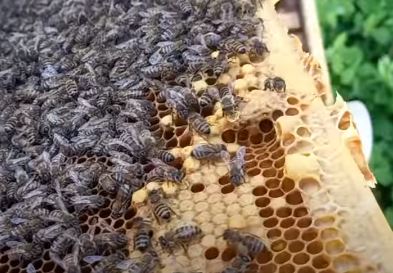
What is a quiet shift queen cell in bees, when do bees lay quiet shift queen cells? Bees lay quiet replacement queen cells if they need to replace the queen; this can happen if she is sick or injured and does not suit the bees.
How many queen cells are there during a quiet queen change?
How many quiet-shift queen cells do bees lay? Unlike swarm queen cells or fistulous queen cells, which can range from several dozen to several hundred in a hive, bees lay few quiet-shift queen cells; as a rule, two or three quiet-shift queen cells can be found per colony.
How to determine the queen cell of a quiet shift
What does a quiet shift queen cell look like? For a beekeeper, it is important to distinguish quiet-shift queen cells from other types of queen cells in order to properly carry out work in the bee colony. There are several ways to distinguish a quiet-shift queen cell from others.
How to distinguish a quiet-shift queen cell from a swarm queen cell
How to distinguish a quiet-shift queen cell from a swarm queen cell? It would seem difficult to distinguish these two types of queen cell. What does the queen cell of the quiet shift look like, visually they are very similar, the bees also build bowls for the queen cells of the quiet shift, in the same places as the swarm queen cells, so visually seeing the queen cell of the quiet shift cannot be distinguished from the swarm one. Then how to distinguish a quiet-shift queen cell from a swarm queen cell? It is necessary to estimate the number of queen cells in the family; if there are several of them in the family, then these are quiet-shift queen cells; if there are more than five, then they can be swarming queen cells.
Find the uterus and see if it is large or not. Look at how much brood there is and its structure, whether there is seeding and in what quantities. Is there any visual damage to the uterus? If you see that the queen is crippled, it means there is a quiet shift of queen cells in the hive. If the queen is large, there is a lot of seeding, open young brood, then the queen cells are in quiet rotation. If the queen has already lost weight and become light, and there is a lot of closed brood in the hive, this means the queen cells are swarming. Are there other signs of preparation for swarming? If not, the family is in working order, which means the queen cells are on a quiet shift. If they continue to rebuild the building frame, then the queen cells are in quiet change.
How to distinguish a quiet shift queen cell from a fistulous queen cell
Quiet-shift queen cells and fistulous queen cells have a big difference, both in size and in placement on the comb. But the most important thing is whether there is a queen in the hive. If there is a queen in the hive, then there should be no fistulous queen cells.
It’s clear how to distinguish quiet-shift queen cells. But what should a beekeeper do with them? As a rule, the best ones are kept, the rest are removed.
As a result, in the presence of quiet-changing queen cells, bees simply and imperceptibly replace the old queen with a new one; several beekeeping technologies are based on this principle, since this is a simple and reliable way to replace the queen with a young one of very good quality. With quiet-shift queen cells, the old queen is present in the family until a young queen emerges from the queen cell, flies around and begins to sow, only after which the old queen is destroyed. There can even be two queens living in a family for some time, an old one and a young one, this is especially developed in gray Caucasian bees.
This type of queen cell is not used in bees for the formation of layering.
Which uterus is better - quiet shift, swarming, fistulous?
Which queen cells are better for swarm or fistula layering? Thus, of all types of queen cells in bees, for the formation of layering, it is most advisable to use swarm queen cells from good families, and also to organize layering on queen cells, queen cells artificially grown in nurse colonies are used.